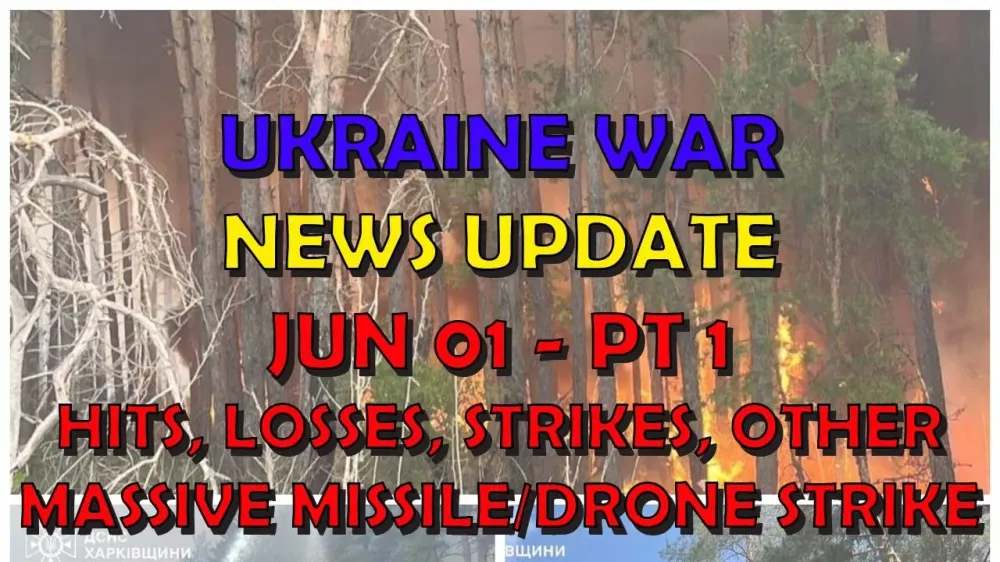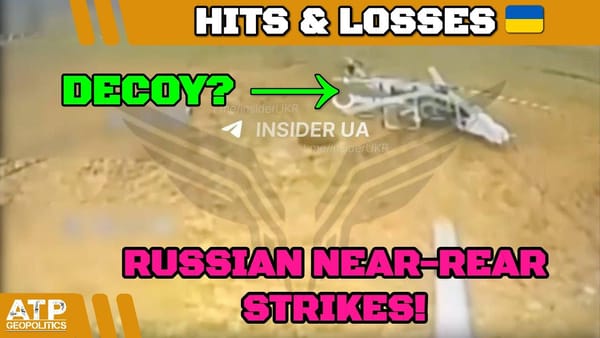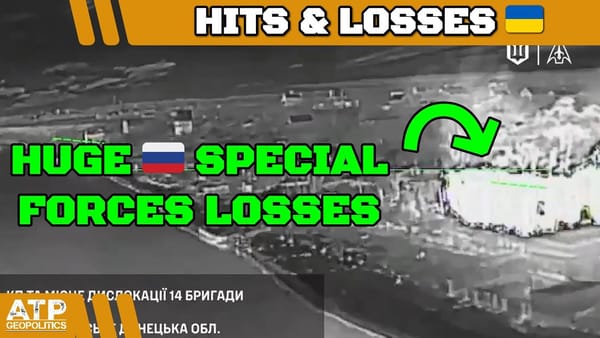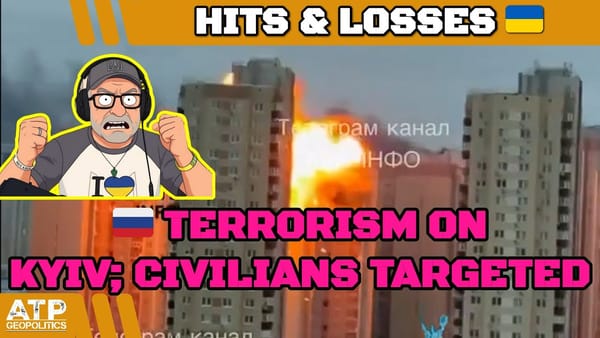Ukraine War Update BUMPER NEWS: Pt 1 - Overnight & Other News & Analysis
Table of Contents 📖
"Russians have now crafted their war strategy around Ukraine being forbidden to strike Russian territory."
Hello Team
🎦 00:00-00:34⏩
Jonathan greets his viewers and notes that the video is a little late due to family matters. He mentions an extra video he posted that morning and prepares to delve into the Ukrainian General Staff's figures for Russian losses.
Return to top⤴️
🪦 DISCLAIMER FOR GENERAL STAFF LOSSES DATA
- These are real people with real lives and real families who love them. Don’t let the numbers sap your humanity.
- These numbers probably aren’t accurate but they’re the best we have and we don’t need them to be accurate to be indicative of patterns of activity.
- All losses are estimates. Losses cannot be counted with accuracy because of the conditions on the ground.
- Both sides would see it to be of their advantage to minimize their own losses maximize the other side’s losses.
- Neither side releases their losses but we have enough transparency from the Ukrainian side to have confidence in they are indicative.
- Personnel losses are hard to count. If a soldier gets injured, heals up, and returns to the front line only to get injured again, is that one loss or two? Also, how to deal with losses from PMC’s or soldiers fighting with RF from occupied territories?
- Equipment losses are hard to count. If an AA complex involves several parts and one part gets disabled, is that a loss, or a fraction of a loss? If a tank gets disabled, repaired, back into the fight, then disabled again, is that one lost tank or two?
- All recorded losses are vulnerable to multiple reporting. We have already seen numerous cases of multiple drones in the air reporting the same loss from different angles as multiple engagements.
- Losses are not always reported on the same day they occurred. It is frequent that drone losses are reported at least 24 hours after other terrestrial equipment losses. Certain losses may not be reported for days or weeks for military intelligence reasons.
Russian Losses (29 May 2024)
🎦 00:34-03:26⏩
Jonathan reviews the General Staff’s figures, highlighting significant losses:
- Personnel: 1,130 (lower end of recent figures)
- Tanks: 12
- Artillery Systems: 44 (double the average)
- Vehicles and Fuel Tanks: 101 (a record)
- Special equipment: 17 (likely a record)
He cites Thierry on Twitter, who notes record monthly losses:
- 8,970 personnel (almost 9,000 more than any previous month)
- 428 tanks (second highest monthly total)
- 1,160 artillery pieces (a new record)
- 1,831 vehicles (a new record)
UK Intelligence Update on Russian Casualties
🎦 03:26-05:20⏩
Jonathan discusses the latest UK intelligence update, which estimates:
- Total Russian casualties (killed and wounded): likely reached 500,000
- Average daily personnel casualties in May: over 1,200 (highest since the war began)
He questions whether this alignment with Ukrainian figures is propaganda or genuine accuracy. The update attributes the high casualty rate to Russia’s attritional offensive and limited troop training, leading to costly wave attacks. It highlights the strain on Russia’s ability to generate capable units due to the constant need for replenishment.
Return to top⤴️
Ukrainian Drone Issue and Russian Reconnaissance
🎦 05:20-08:05⏩
Jonathan highlights the challenge Ukraine faces with Russian reconnaissance drones. He shows footage of a Ukrainian vehicle, possibly carrying air defense equipment, being hit by a Lancet drone after being spotted. He emphasises the ongoing issue of Russian drones operating in Ukrainian airspace, enabling targeted strikes on valuable assets like the Buk SAM system.
Return to top⤴️
Ukrainian Drone-on-Drone Warfare
🎦 08:05-11:32⏩
Jonathan analyses footage of Ukrainian drones engaging Russian reconnaissance drones. He shows examples of:
- A fixed-wing Ukrainian drone pursuing and possibly disabling a Russian drone using electronic warfare.
- An FPV drone seemingly landing on and destroying an Orlan drone.
He discusses the growing use of drone-on-drone tactics, including suicide drones, electronic warfare, and the use of IEDs, citing the example of a Baba Yaga drone being downed by Russian forces.
Return to top⤴️
Russian Military Equipment Losses and Ukrainian Strikes
🎦 11:32-12:08⏩
Jonathan reports the destruction of two Russian Pantsir air defense systems, one in Kharkiv and one in Kherson. He highlights their value as relatively new and sophisticated pieces of equipment.
Return to top⤴️
Strikes in Belgorod and US Restrictions on Weapon Use
🎦 12:08-14:15⏩
Jonathan discusses reports of Ukrainian strikes in Belgorod, Russia, noting the significant activity with over 40 explosions heard. He clarifies the US restrictions on the use of supplied weapons, stating:
- Permission granted for use in Kharkiv and Sumy Oblasts.
- ATACMS usage not approved.
- Range limitations in effect.
He expresses frustration with these restrictions, arguing for Ukraine's right to defend itself by striking Russian military targets.
Return to top⤴️
Further Evidence of Strikes in Belgorod
🎦 14:15-15:08⏩
Jonathan presents footage of a Russian self-propelled howitzer destroyed in Belgorod, though the type of artillery used is unknown. He celebrates the destruction of Russian military equipment within Russian territory.
Return to top⤴️
Russian Troop Behaviour and Vulnerability to Drone Attacks
🎦 15:08-16:19⏩
Jonathan shows footage of an FPV drone attack on Russian soldiers, using it to critique their tactical behaviour. He criticises their tendency to bunch together behind cover when under drone attack, labeling it “absolutely insane" and advocating for dispersal as a safer alternative.
Return to top⤴️
Russian Railway Disruptions and Impact on Mentality
🎦 16:19-18:08⏩
Jonathan notes an increase in incidents on Russian railways, highlighting the derailment of 29 coal wagons in the Amur region. While unsure if it was sabotage or an accident, he underscores the logistical and psychological impact of such events, suggesting they contribute to growing unease within Russia. He sees these disruptions as potentially part of a strategy to undermine Russian morale and confidence in their government's handling of the war.
Return to top⤴️
Russian Missile and Drone Attacks on Ukrainian Infrastructure
🎦 18:08-19:17⏩
Jonathan shifts focus to the previous night's Russian attacks on Ukrainian energy infrastructure:
- Over 50 missiles and 50 Shahed drones launched.
- Targets in southern, central, and western Ukraine.
- Two thermal power plants severely damaged.
- Sixth major attack on Ukrainian energy infrastructure in 2.5 months.
- Additional strikes reported in Dnipropetrovsk and Zaporizhia.
Analysis of Russian Attack and Ukrainian Air Defence Performance
🎦 19:17-26:31⏩
Jonathan analyses the Russian attack, stating:
- While widespread and challenging, it wasn’t as large as previous assaults.
- Damaged energy infrastructure takes significant time to repair, impacting Ukraine’s economy and society.
- Russia's targeting of civilian infrastructure is despicable.
He commends Ukraine’s air defense:
- 46 out of 47 Shahed drones shot down (a significant improvement).
- 30 out of 35 cruise missiles intercepted (still a good rate considering the volume).
Jonathan speculates that:
- Improved mobile units, lower-tech air defenses, and an enhanced radar network are contributing to Ukraine’s success in countering drones.
- Russia’s ability to launch larger-scale attacks may be hindered by losses of missile carriers in the Black Sea Fleet.
Details of Russian Strikes and Ukrainian Casualties
🎦 26:31-28:33⏩
Jonathan, citing information from Tim White, provides additional details on the attacks:
- Serious damage to two thermal power plants.
- Russia claims to have also targeted Ukrainian military assets.
- Injured reported and fires broke out in various locations.
- A strike was reported on a group of Ukrainian specialists involved in planning drone missions.
Jonathan acknowledges the significant challenges posed by these ongoing attacks.
Return to top⤴️
Ukrainian Strikes in Belgorod and Russian Responses
🎦 28:33-29:46⏩
Jonathan turns to Ukrainian strikes in Belgorod, noting:
- Large-scale missile attack launched by Ukrainian forces.
- Use of HIMARS systems likely, though potentially limited by US restrictions.
- Around 40 explosions heard in Belgorod, indicating significant Ukrainian activity.
- Two large fires reported near a gas compressor station connected to the Turkish Stream pipeline.
Jonathan sees this as a strategic move by Ukraine, targeting Russian military assets and energy infrastructure. He applauds the potential disruption of Russian gas exports to countries like Serbia, Hungary, and Austria, highlighting their support for Putin.
Return to top⤴️
Russian "Friendly Fire" Incidents
🎦 29:46-33:47⏩
Jonathan highlights the issue of Russian “friendly fire” incidents, referencing:
- 78 documented instances of Russian ordnance accidentally falling on their own territory in the past three months.
- These incidents likely represent a small fraction of the actual number.
He humorously speculates on the possibility of Russian pilots intentionally missing targets but acknowledges it’s more likely due to incompetence or equipment malfunction.
Return to top⤴️
Ukrainian Prisoner Swap
🎦 33:47-35:28⏩
Jonathan reports a prisoner exchange between Ukraine and Russia, resulting in the release of 75 Ukrainians. He expresses relief, as this is the first swap in a considerable period. He notes the contrast in the physical condition of released prisoners, with Ukrainians appearing severely malnourished compared to their Russian counterparts.
Return to top⤴️
Ukrainian Defender's Call for ATACMS and Kharkiv Offensive Analysis
🎦 35:28-41:14⏩
Jonathan shares a quote from Ukrainian drone unit commander, Kursai Magyar, expressing frustration with the lack of ATACMS and its impact on their ability to target Russian airbases. He discusses Magyar’s redeployment from Kherson to Kharkiv, suggesting it indicates a shift in Ukrainian strategy, potentially in response to a renewed Russian offensive in the region. He analyses the ongoing offensive in Kharkiv, which he and Phillips O'Brien consider a Russian strategic failure. He points to:
- Failure to achieve objectives on schedule.
- Inability to establish artillery positions close enough to effectively target Kharkiv.
- Lack of a contiguous buffer zone along the border.
- Reliance on inadequate equipment (golf carts, motorbikes).
He questions the logic of Russia reinforcing a failing offensive, potentially falling victim to the sunk cost fallacy.
Return to top⤴️
Military Aid, Decoy Tactics and Environmental Impact
🎦 41:14-44:47⏩
Jonathan mentions the arrival of M777 howitzers for Ukraine. He observes the increasing use of decoys by both sides, acknowledging their effectiveness while pondering their cost-benefit analysis. He expresses sadness over the environmental impact of the war, specifically referencing nine forest fires in the Kharkiv region, covering over 3,000 hectares, most caused by Russian actions. He laments the destruction of ecosystems and the long-term consequences for the environment.
Return to top⤴️
Wrap Up
44:47-44:55⏩
Jonathan concludes the video, apologising for the delay and bidding his viewers farewell.
Return to top⤴️



